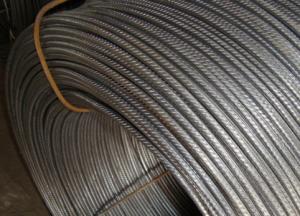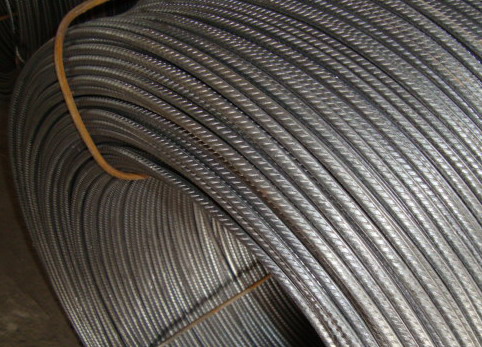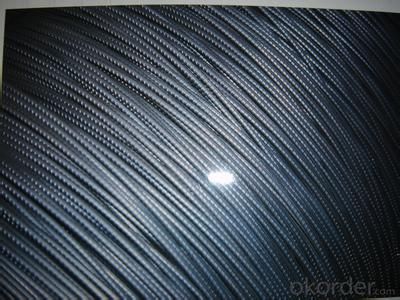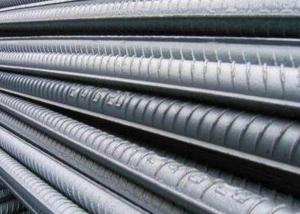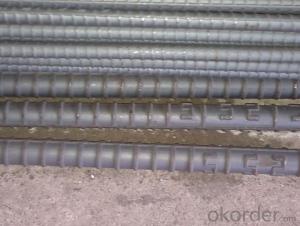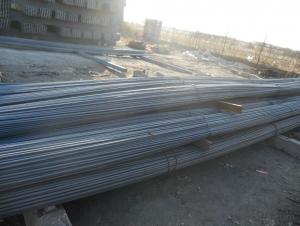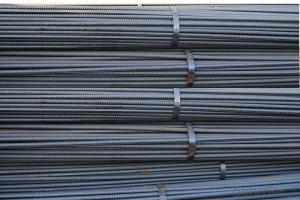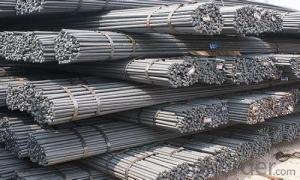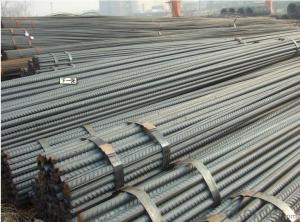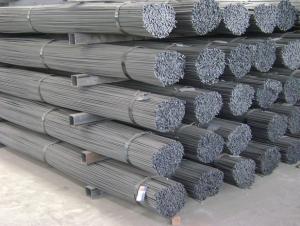Six mm Cold Rolled Steel Rebars with Good Quality
- Loading Port:
- Tianjin
- Payment Terms:
- TT or LC
- Min Order Qty:
- 50 m.t.
- Supply Capability:
- 15000 m.t./month
OKorder Service Pledge
OKorder Financial Service
You Might Also Like
Specifications of Six mm Cold Rolled Steel Rebars with Good Quality:
Name | Six mm Cold Rolled Steel Rebars | |
Diameter | 5mm, 5.5mm, 6mm, 6.5mm, 7mm, 8mm, 9mm, 10mm, 11mm, 12mm, | |
Length | 6M, 9M, 12M or as required | |
Price | Keep lower operating costs so as to offer competitive price for our clients | |
Label | to be specified by customer, generally, each bundle has1-2 labels | |
Application | Building, construction | |
Invoicing | Actual or Theoretical Weight Basis as buyer’s request. | |
Theoretical weight and section area of each diameter of Six mm Cold Rolled Steel Rebars with Good Quality as below for your information:
Diameter(mm) | Section area (mm²) | Mass(kg/m) | ||
6 | 28.3 | 0.222 | ||
Packaging & Delivery of Six mm Cold Rolled Steel Rebars with Good Quality:
Packaging Detail: products are packed in bundle and then shipped by container or bulk vessel, deformed bar is usually naked strapping delivery, when storing, please pay attention to moisture proof. The performance of rust will produce adverse effect.
Each bundle weight: 2-3MT, or as required
Payment terms: TT payment in advance or Irrevocable LC at sight.
Trade terms :FOB, CFR, CIF
Delivery Detail: within 45 days after received advanced payment or LC.
FAQ:
Q1: Why buy Materials & Equipment from OKorder.com?
A1: All products offered byOKorder.com are carefully selected from China's most reliable manufacturing enterprises. Through its ISO certifications, OKorder.com adheres to the highest standards and a commitment to supply chain safety and customer satisfaction.
Q2: How do we guarantee the quality of our products?
A2: We have established an advanced quality management system which conducts strict quality tests at every step, from raw materials to the final product. At the same time, we provide extensive follow-up service assurances as required.
Q3: How soon can we receive the product after purchase?
A3: Within three days of placing an order, we will arrange production. The shipping date is dependent upon the quatity, how many sizes you want and the plan of production, but is typically 1 month to 2 month days from the beginning of production.
Images of Six mm Cold Rolled Steel Rebars with Good Quality:
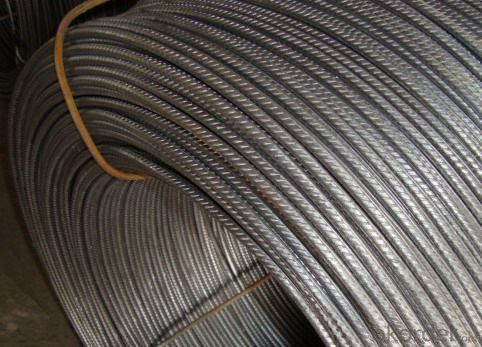
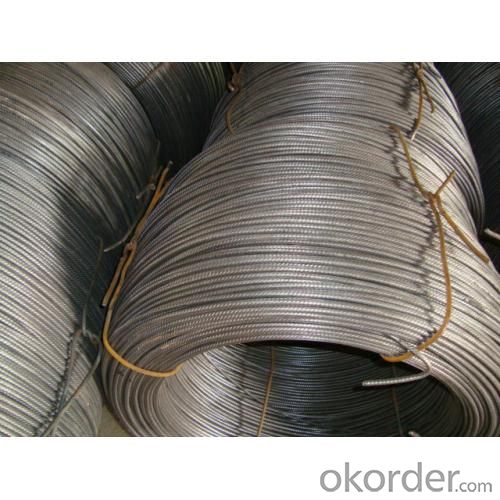
*If you would like to get our price, please inform us the size, standard/material and quantity. Thank you very much for your attention.
- Q: What are the factors considered in designing with steel rebars?
- When designing with steel rebars, several factors are considered to ensure the structural integrity and safety of the final structure. These factors include: 1. Structural requirements: The first consideration is the structural requirements of the project. This includes determining the load capacity, the type of structure, and the desired strength and durability. 2. Building codes and regulations: Designers must adhere to building codes and regulations set by local authorities. These codes dictate the minimum standards for materials, design, and construction, ensuring that the structure meets safety and performance requirements. 3. Material properties: Steel rebars come in various grades and sizes, each with its own set of mechanical properties. The designer must select the appropriate grade and size of rebars based on the structural requirements and specifications. 4. Reinforcement placement and spacing: The proper placement and spacing of steel rebars are crucial for providing adequate reinforcement. This includes determining the number of rebars, their diameter, and the spacing between them to ensure even distribution of forces and prevent structural failure. 5. Concrete cover: Steel rebars must be adequately covered by concrete to protect them from corrosion. The designer must determine the required concrete cover based on environmental conditions, exposure to moisture or chemicals, and the desired service life of the structure. 6. Corrosion protection: Steel rebars are susceptible to corrosion, which can weaken the structure over time. Designers must consider methods of corrosion protection, such as using epoxy-coated rebars, providing additional concrete cover, or implementing cathodic protection systems. 7. Construction process: The design should also take into account the construction process and ease of installation. This includes considering the accessibility of rebars, the feasibility of construction techniques, and any special requirements for placement and anchorage. By considering these factors, designers can create steel rebar designs that meet safety standards, provide adequate reinforcement, and ensure the longevity of the structure.
- Q: Are steel rebars suitable for use in historical building restoration?
- When considering the restoration of historical buildings, it is important to carefully evaluate the suitability of steel rebars. The specific needs of the project and the significance of the building must be taken into account. Steel rebars offer advantages such as strength, durability, and ease of installation, which can be beneficial for reinforcing and stabilizing historical structures. However, it is crucial to ensure that the use of steel rebars does not compromise the building's original character and integrity. In certain cases, preservation guidelines may prevent or restrict the use of steel rebars in historical buildings. For example, if a building is classified as a protected monument, the use of steel rebars may be limited to preserve its original materials and construction methods. In these instances, alternative reinforcement materials like timber, stone, or composite materials may be more appropriate. Moreover, consulting preservation experts, architects, and structural engineers who specialize in historical building restoration is vital. They can offer valuable insights and recommendations regarding the most suitable reinforcement options for a particular project. Their expertise can help strike a balance between the structural requirements of the building and the preservation of its historical value. Ultimately, determining the suitability of steel rebars for historical building restoration requires a thorough assessment of the building's historical significance, the specific needs of the restoration project, and adherence to preservation guidelines. With careful planning and consideration, steel rebars can be successfully incorporated into the restoration process, ensuring the long-lasting stability of the historical structure while preserving its unique heritage.
- Q: What are the factors that determine the spacing of steel rebars in a concrete structure?
- The spacing of steel rebars in a concrete structure relies on various factors that guarantee the concrete's structural integrity and strength. These factors encompass: 1. Structural Design: The spacing of rebars is influenced by the structural design requisites and specifications of the concrete structure. Engineers take into account the loads, stresses, and forces that the structure will endure and compute the necessary reinforcement spacing accordingly. 2. Concrete Strength: The concrete's strength used in the structure is a pivotal determinant in establishing rebar spacing. Higher-strength concrete may necessitate closer spacing of rebars to provide ample reinforcement and prevent cracking or failure under load. 3. Rebar Diameter: The diameter of the steel rebars also contributes to determining the spacing. Thicker or larger diameter rebars may require wider spacing, while thinner rebars typically necessitate closer spacing to deliver the desired reinforcement. 4. Bar Bending and Placing: The ease of bending and placing the rebars during construction is another crucial factor. Often, practical considerations dictate the spacing, such as guaranteeing proper access for workers and equipment and facilitating the concrete pouring process. 5. Environmental Factors: Environmental conditions, including exposure to corrosive substances or extreme weather conditions, can impact rebar spacing. Closer spacing may be necessary in corrosive environments to provide additional protection against rust and deterioration. 6. Building Codes and Regulations: Local authorities or relevant organizations establish building codes and regulations that set the minimum requirements for rebar spacing in concrete structures. These codes ensure compliance with safety standards and offer guidelines for construction practices. In conclusion, the spacing of steel rebars in a concrete structure is a crucial aspect in ensuring its strength, durability, and resilience. It relies on a combination of factors, including structural design, concrete strength, rebar diameter, construction practicalities, environmental considerations, and adherence to building codes and regulations.
- Q: What is the role of steel rebars in preventing structural deformation?
- Various construction projects, including buildings, bridges, and other infrastructure, rely heavily on steel rebars to prevent structural deformation. These rebars, when embedded in concrete, strengthen its ability to withstand tension, as concrete alone is vulnerable to cracking when subjected to tensile stress. The key purpose of steel rebars is to counteract tensile forces that can cause structural deformation. When external loads or forces, such as gravity or wind, are applied to a structure, it experiences both compressive and tensile stresses. While concrete is well-suited to handle compressive forces, it tends to fail under tension and develop cracks. By incorporating steel rebars into the concrete, the overall strength and load-bearing capacity of the structure are significantly enhanced. The rebars serve as tension members, absorbing tensile forces and preventing the concrete from cracking, thus maintaining its integrity. This reinforcement ensures that the forces are distributed more uniformly throughout the structure, minimizing the risk of localized failures or deformations. Moreover, rebars also play a crucial role in controlling and limiting crack propagation caused by factors like shrinkage, temperature fluctuations, or seismic events. These steel bars bridge and hold together any cracks that may occur in the concrete, preventing them from widening and compromising the structure's stability. Steel rebars also contribute to the ductility of the reinforced concrete structure. Ductility refers to a material's ability to deform under stress before reaching its breaking point. The presence of rebars allows the structure to undergo controlled deformation, which is especially important during extreme events like earthquakes or excessive loading. The rebars provide the necessary strength and flexibility to absorb and dissipate energy, thereby reducing the likelihood of catastrophic failure. In conclusion, steel rebars play a crucial role in preventing structural deformation by reinforcing the concrete, enhancing its tensile strength, controlling crack propagation, and improving overall structural integrity. By withstanding tensile forces and enhancing ductility, rebars are essential for ensuring the safety and longevity of various construction projects.
- Q: Can steel rebars be used in the construction of sports stadiums or arenas?
- Yes, steel rebars can certainly be used in the construction of sports stadiums or arenas. Steel rebars are commonly utilized as reinforcement in concrete structures, and their high tensile strength and durability make them well-suited for large-scale projects like sports stadiums. The rebars provide additional support and stability to the concrete, helping to withstand the immense loads and forces that stadiums and arenas may experience during events. Additionally, steel rebars can be easily shaped and bent to fit the specific needs and design requirements of the structure, making them a versatile choice for construction purposes.
- Q: Can steel rebars be used in power plant construction?
- Yes, steel rebars can be used in power plant construction. Steel rebars, also known as reinforcing bars, are commonly used in the construction industry to provide strength and support to concrete structures. In power plant construction, steel rebars are often used to reinforce concrete foundations, walls, and structural elements such as columns and beams. The high tensile strength and durability of steel rebars make them ideal for withstanding the heavy loads and extreme conditions typically encountered in power plant environments. Moreover, steel rebars can also be used in the construction of reinforcing cages for underground pipelines and cooling towers, enhancing the overall strength and stability of the power plant infrastructure.
- Q: What are the factors to consider while choosing the right type of steel rebar for a project?
- When choosing the right type of steel rebar for a project, several factors need to be considered. These factors include the grade and quality of the steel, the required strength and durability, the environmental conditions of the project site, the structural design and specifications, the budget, and any specific regulations or standards that need to be followed. Additionally, factors such as corrosion resistance, weldability, and availability of the steel rebar should also be taken into account. Overall, a comprehensive analysis of these factors will help in selecting the most suitable steel rebar for the project.
- Q: What are the guidelines for installing steel rebars in concrete columns?
- To ensure the structural integrity and durability of concrete columns, there are several important considerations to be made when installing steel rebars. Here are some guidelines to follow: 1. Reinforcement design: Begin by creating a proper reinforcement design that specifies the rebars' size, length, and spacing. This design should be prepared by a qualified engineer or consultant, keeping in mind the load-bearing requirements of the column and the structural design standards. 2. Rebar preparation: Before installation, thoroughly clean the steel rebars to eliminate any rust, oil, or other contaminants that could hinder the bond between the rebar and the concrete. Additionally, cut and bend the rebars' ends correctly according to the reinforcement design. 3. Placement: Accurately position the rebars as specified in the reinforcement design. They should be placed in the center of the column and secured to maintain the required spacing and alignment. Avoid allowing the rebars to touch the formwork or be placed too close to the edges of the column. 4. Splicing: If the height of the column exceeds the length of the rebar, splicing becomes necessary. Follow approved methods such as lap splicing, mechanical couplers, or welded splices. Ensure the spliced rebars have sufficient overlap length and provide a continuous load path. 5. Tying: Properly tying the rebars is crucial to maintain their position during concrete pouring. Use binding wire or other approved tying methods to securely tie the rebars at the intersections. The ties should be tight enough to prevent displacement but not so tight as to damage the rebars. 6. Concrete pouring: Once the rebars are installed, pour the concrete into the formwork, completely surrounding the rebars. Take care to avoid segregation or honeycombing in the concrete, as this can compromise the bond between the rebars and the concrete. 7. Concrete cover: The reinforcement design will specify the required concrete cover over the rebars. This cover protects the rebars from corrosion and provides fire resistance. It is crucial to maintain the specified concrete cover throughout the height of the column and ensure it is not compromised during construction. 8. Quality control: Regularly inspect and implement quality control measures during the installation process. This includes checking the alignment, spacing, and cover of the reinforcement, as well as verifying the use of proper tying methods and splicing techniques. By following these guidelines, you can effectively install steel rebars in concrete columns, ensuring their structural strength and durability. Remember to adhere to local building codes and standards and seek professional advice if necessary to ensure the proper installation of rebars in concrete columns.
- Q: What are the guidelines for proper anchoring of steel rebars in concrete structures?
- Proper anchoring of steel rebars in concrete structures is crucial for ensuring the structural integrity and stability of the construction. The guidelines for proper anchoring of steel rebars are as follows: 1. Embedment length: The rebars should be embedded in the concrete for a certain length to provide sufficient bond strength. The required embedment length is determined by the design specifications and depends on factors such as rebar diameter, concrete strength, and load conditions. 2. Lap length: When connecting two rebars, a minimum lap length is required to ensure continuity of reinforcement. The lap length is determined based on the rebar diameter, concrete strength, and structural design requirements. 3. Concrete cover: Adequate concrete cover should be provided to protect the rebars from corrosion and fire. The concrete cover is the distance between the outer surface of the rebars and the nearest concrete surface. It depends on factors such as the environment, fire resistance requirements, and durability considerations. 4. Spacing and arrangement: The rebars should be spaced properly and arranged as per the structural design requirements. The spacing between rebars depends on the structural load and design specifications. Improper spacing can lead to inadequate reinforcement and compromise the structural strength. 5. Proper positioning: The rebars should be positioned accurately as per the design drawings and specifications. They should be placed in the concrete formwork before pouring the concrete to achieve the desired structural behavior. Improper positioning may lead to rebar misalignment or inadequate concrete cover. 6. Mechanical anchorage: Mechanical anchorage devices such as rebar couplers, anchor bolts, or hooks can be used to enhance the anchoring of rebars in concrete structures. These devices provide additional reinforcement and prevent slippage or pull-out of the rebars under load. 7. Quality control: Regular inspection and quality control measures should be implemented to ensure adherence to the anchoring guidelines. This includes checking rebar dimensions and spacing, embedment depth, concrete cover, and ensuring proper installation techniques. It is important to note that these guidelines may vary depending on the specific project requirements, local building codes, and design specifications. Therefore, it is essential to consult the structural engineer or refer to the relevant building codes and standards for the specific guidelines applicable to each construction project.
- Q: Can steel rebars be used in historical buildings restoration?
- Indeed, the utilization of steel rebars is applicable in the restoration of historical buildings. These rebars, commonly employed in construction, are capable of providing structural reinforcement to fortify the existing structures of such buildings. Through careful implementation, the integration of steel rebars can effectively restore stability and integrity while preserving the historical significance of these structures. Nevertheless, it is crucial to consider the specific requirements and guidelines for restoring historical buildings, thus ensuring that the use of steel rebars does not compromise the authenticity or aesthetic value of the structure. Successful incorporation of steel rebars in the restoration process necessitates proper planning, consultation with preservation experts, and adherence to conservation principles.
Send your message to us
Six mm Cold Rolled Steel Rebars with Good Quality
- Loading Port:
- Tianjin
- Payment Terms:
- TT or LC
- Min Order Qty:
- 50 m.t.
- Supply Capability:
- 15000 m.t./month
OKorder Service Pledge
OKorder Financial Service
Similar products
Hot products
Hot Searches
Related keywords
